Three More Decades of a Cooling Planet
Note: the latest Arctic Blast is setting low temperature records across the Pacific Northwest. The findings below indicate that we better get used to it.
by Ken Schlichte
Dr. Jorge Sanchez-Sesma’s Technical Note, Multi-Centennial Scale Analysis and Synthesis of an Ensemble Mean Response of ENSO to Solar and Volcanic Forcings [here] includes the following Abstract:
Abstract
The response of El Niño Southern Oscillation (ENSO) to solar and volcanic radiative forcings over the past millennium is reanalyzed and extrapolated based on historical data and numerical experiments employing the Zebiak–Cane (ZC) model of the tropical Pacific coupled ocean–atmosphere system. The results suggest a self-similarity of the centennial scale component of the reconstructed ENSO record with a shift in frequencies around 1700 AD when the frequencies almost double. This shift of regime puts forward the non-linearity of ENSO climate with a possible centennial scale forecast, suggesting an ENSO trend toward La Niña conditions for the next three decades.
We are now experiencing the effects of the current La Nina and it is worth noting that Dr. Sanchez-Sesma has presented data suggesting an ENSO trend toward La Nina conditions for the next three decades.
Note: see also Don J. Easterbrook. 2008. Global Cooling Is Here! Evidence for Predicting Global Cooling For the Next Three Decades [here].
Forestry education Restoring cultural landscapes Saving Forests
by admin
leave a comment
Four New Colloquia Posts
After a long hiatus (been working on a paper) we are pleased to announce the posting of four new works in our Colloquia:
Nataraja: India’s Cycle of Fire by Stephen J. Pyne may be found [here]. Dr. Pyne’s essay on the history of fire on the Indian subcontinent is a chapter from World Fire: The Culture of Fire on Earth (Pyne S.J., 1997, Univ of WA Press). He graciously sent it to W.I.S.E. as a companion piece to Roger Underwood’s Baden-Powell and Australian Bushfire Policy [Part 1 here, Part 2 here]. An extracted gem of a quote:
India’s biota, like Shiva, dances to their peculiar rhythm while fire turns the timeless wheel of the world. Perhaps nowhere else have the natural and the cultural parameters of fire converged so closely and so clearly. Human society and Indian biota resemble one other with uncanny fidelity. They share common origins, display a similar syncretism, organize themselves along related principles. Such has been their interaction over millennia that the geography of one reveals the geography of the other. The mosaic of peoples is interdependent with the mosaic of landscapes, not only as a reflection of those lands but as an active shaper of them (emphasis added). Indian geography is thus an expression of Indian history, but that history has a distinctive character, of which the nataraja is synecdoche, a timeless cycle that begins and ends with fire.
Stand Reconstruction and 200 Years of Forest Development on Selected Sites in the Upper South Umpqua Watershed, W.I.S.E. White Paper 2010-5 by yours truly (and the cause of the recent hiatus), examines the forest development pathways over the last 200 years in an Oregon Cascades watershed:
Several lines of evidence suggest that the prairies, savannas, and open forests have been persistent vegetation types in the Upper South Umpqua Watershed for the last few thousand years, at least. Precontact forest development pathways were mediated by frequent, purposeful, anthropogenic fires deliberately set by skilled practitioners, informed by long cultural experience and traditional ecological knowledge in order to achieve specific land management objectives. At a landscape scale the result was maintenance of an (ancient) anthropogenic mosaic of agro-ecological patches. In the absence, over the last 150 years, of purposeful anthropogenic fires, the anthropogenic mosaic has been invaded and obscured by (principally) Douglas-fir. As a result, the Upper South Umpqua Watershed is now at risk from a-historical, catastrophic stand-replacing fires.
In Pre-Columbian agricultural landscapes, ecosystem engineers, and self-organized patchiness in Amazonia by Doyle McKey, Stephen Rostain, Jose Iriarte, Bruno Glaser, Jago Jonathan Birk, Irene Holst, and Delphine Renard, the authors examine the manner in which arthropods and other critters have maintained nutrient-rich soils long after the pre-Columbian human residents created said soils:
Combining archeology, archeobotany, paleoecology, soil science, ecology, and aerial imagery, we show that pre-Columbian farmers of the Guianas coast constructed large raised-field complexes, growing on them crops including maize, manioc, and squash. Farmers created physical and biogeochemical heterogeneity in flat, marshy environments by constructing raised fields. When these fields were later abandoned, the mosaic of well-drained islands in the flooded matrix set in motion self-organizing processes driven by ecosystem engineers (ants, termites, earthworms, and woody plants) that occur preferentially on abandoned raised fields.
In The Columbian Encounter and the Little Ice Age: Abrupt Land Use Change, Fire, and Greenhouse Forcing by Robert A. Dull, Richard J. Nevle, William I. Woods, Dennis K. Bird, Shiri Avnery, and William M. Denevan, the (accomplished and distinguished) authors posit that Old World disease epidemics in the 1500’s eliminated anthropogenic fire along with the human population of Amazonia. The decline in human-driven carbon cycling was at a continental scale, and the reduction in emitted CO2 may have induced the Little Ice Age:
Pre-Columbian farmers of the Neotropical lowlands numbered an estimated 25 million by 1492, with at least 80 percent living within forest biomes. It is now well established that significant areas of Neotropical forests were cleared and burned to facilitate agricultural activities before the arrival of Europeans. Paleoecological and archaeological evidence shows that demographic pressure on forest resources—facilitated by anthropogenic burning—increased steadily throughout the Late Holocene, peaking when Europeans arrived in the late fifteenth century. The introduction of Old World diseases led to recurrent epidemics and resulted in an unprecedented population crash throughout the Neotropics. The rapid demographic collapse was mostly complete by 1650, by which time it is estimated that about 95 percent of all indigenous inhabitants of the region had perished. We review fire history records from throughout the Neotropical lowlands and report new high-resolution charcoal records and demographic estimates that together support the idea that the Neotropical lowlands went from being a net source of CO2 to the atmosphere before Columbus to a net carbon sink for several centuries following the Columbian encounter. We argue that the regrowth of Neotropical forests following the Columbian encounter led to terrestrial biospheric carbon sequestration on the order of 2 to 5 Pg C, thereby contributing to the well-documented decrease in atmospheric CO2 recorded in Antarctic ice cores from about 1500 through 1750, a trend previously attributed exclusively to decreases in solar irradiance and an increase in global volcanic activity. We conclude that the post-Columbian carbon sequestration event was a significant forcing mechanism.
It’s a hypothesis that is very difficult to test, but one that recognizes the historical impact of human beings on the environment. That theme permeates all four new Colloquia postings.
Our protocol with Colloquia postings is that comments there must be scholarly, commensurate with the scientific efforts of the authors. Less than scholarly comments on any of the postings are welcome, but should be placed here (see the leave a comment aplet below).
We endeavor to post the best, cutting-edge research papers, and all of these meet our stringent criteria. They are not too technical for the lay audience, though. I hope you enjoy them.
Oregon State Budget $5 Billion In the Hole
Note: the following is excerpted from a longer letter.
Oregon’s December Forecast & Charting A New Course
From OR State Rep. Richardson’s Newsletter, November 19, 2010
I am State Representative Dennis Richardson and I write this newsletter for Oregonians interested in what can be done to make Oregon a better place to live and work. This edition focuses on two subjects, the breaking news on Oregon’s revenue, and the message Oregon voters recently sent to the Legislators.
Today, the Oregon’s State Economist released the Quarterly Revenue Forecast that showed a “smoke and mirrors” increase in 2009-11 revenue. In reality, a reduction of $40 Million would normally have been disclosed for the remaining seven months of this biennium.
Unknown to most of us, the Oregon Dept. of Revenue recently announced an increase in the percentage of State payroll withholdings beginning Jan. 1, 2011. Although the increase in payroll deductions apply to the 2011 tax year, the withholdings from January 1 – June 30, 2010, will appear on the State’s balance sheet as current budget revenue, even though much of it will be returned to the wage-earners after their 2011 tax returns are filed. In other words, today’s forecast artificially shows an increase in 2009-11 State revenue of $61.9 million, when the actual revenue expectations, without the artificial bump-up in withholding, would have shown a $40 million decrease in 2009-11 revenue since the Sept. 2010 Forecast. …
The actual $40 million decrease in State revenue is the tenth consecutive reduction in revenue estimates. Since the close the 2009 Legislative Session, Oregon’s anticipated revenue has fallen by 1.3 billion. …
The size, duration and extent of Oregon’s economic recession have placed all Oregonians in a precarious financial situation. To balance the current 2009-11 State Budget required cobbling together $1.6 billion in one-time money—primarily composed of federal stimulus money, state savings accounts and agencies’ ending fund balances. In addition to replacing the $1.6 billion needed to balance the current budget, in 2011-13 an additional $2.2 billion will be needed to maintain Oregon’s current service level “CSL” for the next two-years. Thus, assuming Oregon’s revenue remains constant, $3.8 billion in additional revenue would be needed to balance the next budget.
Unfortunately, Oregon’s revenues have not remained constant. In fact, Oregon’s revenues remain in free-fall. In a previous newsletter I explained the August 2010 Revenue Forecast disclosed that Oregon’s expected revenues had dropped more than $1.3 Billion since the 2009 legislative session ended. Today’s news confirmed that assessment.
The significance of a $1.3 billion decrease in State revenue is stunning. In addition to the $3.8 billion discussed above, that would have been needed if revenues had been stable, an additional $1.3 billion will be needed to compensate for recent losses in anticipated state revenues. Thus, Oregon now faces a $5.1 billion shortfall going into the 2011 legislative session, unless there is a dramatic and immediate economic recovery.
Spending freezes and across-the-board cuts will not fill a $5 billion hole. The state simply cannot resolve a $5 billion shortfall without major structural reforms in both what services are provided and how they are provided. …
Environmental Issues: What’s real and what’s nonsense?
Presentation to the Lake Oswego Lions Club, Nov 17, 2010
by Gordon J. Fulks, PhD Physics
Full text [here]
The story of environmentalism is generally portrayed as one of citizens triumphing over evil corporate polluters, of public awareness, science, and affluence working together to solve pressing problems. There is no problem so huge or so abstract that we cannot solve it if we put our minds to it. And solving these problems yields all sorts of positive side-effects and no drawbacks.
While that may be the perception, it is far from the fact. Public awareness is easily swayed by media campaigns that are little more than propaganda and supported by a press that would rather take sides than present balanced reports. Science is largely bought and paid for by politicians who control the agenda and the outcome. And our affluence, or what is left of it, is viewed as an inexhaustible source of revenue for whatever fantastic ideas the political class can dream up. …
We are perpetually told that we are poisoning the planet with everything from pesticides to carbon dioxide, such that our world is rapidly becoming unlivable. This feeds our enormous egos that tell us we are far more important to this planet than we really are. …
more »
Federal forest policy Monkeywrenching forests Politics and politicians
by admin
leave a comment
OR State Forester Resigns Upon Request of the Board of Forestry
Announcement by Oregon Board of Forestry chair John Blackwell
October 19, 2010 [here]
For immediate release
Oregon State Forester Marvin Brown is stepping down at the end of the year, Board of Forestry Chair John L. Blackwell announced Monday. The Board accepted Brown’s resignation after determining that the Department of Forestry needs fresh leadership.
Blackwell, of Portland, said the seven-member board believes that new leadership is essential as the board and the Oregon Department of Forestry address complex and difficult issues ahead.
“Marvin has deep knowledge of forestry, and of the many public benefits that sound forest management provides,” Blackwell said. “We thank him for his steady leadership and professionalism during challenging times.”
He praised Brown’s role in improving management plans for state-owned forests, and in guiding the board in carrying out Governor Ted Kulongoski’s direction to provide a voice and vision for Oregonians in the management of federal forestlands, the bulk of Oregon’s forestland base.
“For nearly eight years, Marvin Brown has been a key member of my natural resources cabinet,” Kulongoski said. “From guiding the discussion on federal forestlands to acquisition of the first new state forest in more than 60 years, Marvin leaves with a solid record of achievement. I wish him all the best in his new endeavors.”
The Board of Forestry’s members, who are nominated by the governor and confirmed by the state Senate, oversee forest policy matters within the state’s jurisdiction, and appoint the state forester, who serves as director of the Department of Forestry. … [more]
Comments on the State Forester Resignation
Natural Resource Report, October 21, 2010 [here]
The Oregon Department of Forestry Department announced this week that the State Forester, Marvin Brown, is leaving at the close of 2010. Below are some quotes on the resignation and the official press release from the Department of Forestry. … [more]
President Václav Klaus: Inaugural Annual GWPF Lecture
Global Warming Policy Foundation, 21 October 2010 [here]
The Climate Change Doctrine is Part of Environmentalism, Not of Science
It is a great honor for me to be here tonight, getting a chance to deliver the inaugural lecture of the Global Warming Policy Foundation to such a distinguished audience.
Even though it may seem that there is a whole range of institutions both here and overseas which bring together and support those who openly express doubts about the currently prevailing dogma of man-made global warming and who dare to criticize it, it apparently is still not enough. We are subject to a heavily biased and carefully organized propaganda and a serious and highly qualified forum here, on this side of the Atlantic, that would stand for rationality, objectivity and fairness in public policy discussion is more than needed. That is why I consider the launching of the foundation an important step in the right direction.
We should keep saying very loudly that the current debate about global warming –and I agree with the Australian paleoclimatologist Prof. Carter that we should always speak about “dangerous human caused global warming” because it is not “warming per se that we are concerned with”[1] – is in its substance not part of the scientific discourse about the relative role of a myriad of factors influencing swings in global temperature but part of public policy debate about man and society. As R. M. Carter stresses in his recent book, “the global warming issue long ago ceased being a scientific problem.”[2]
The current debate is a public policy debate with enormous implications.[3] It is no longer about climate. It is about the government, the politicians, their scribes and the lobbyists who want to get more decision making and power for themselves. It seems to me that the widespread acceptance of the global warming dogma has become one of the main, most costly and most undemocratic public policy mistakes in generations. The previous one was communism. …
It is not a new doctrine.[16] It has existed under various headings and in various forms and manifestations for centuries, always based on the idea that the starting point of our thinking should be the Earth, the Planet, or Nature, not Man or Mankind.[17] It has always been accompanied by the plan that we have to come back to the original state of the Earth, unspoiled by us, humans.[18] The adherents of this doctrine have always considered us, the people, a foreign element.[19] They forget that it doesn’t make sense to speak about the world without people because there would be no one to speak. In my book, I noted that “if we take the reasoning of the environmentalists seriously, we find that theirs is an anti-human ideology” … [more]
Richardson Recommends No Vote On OR Measure 76
by Rep. Dennis Richardson, Central Point
Note: from his email newsletter, Oct 21, 2010
Negative on Measure 76.
In 1998 Measure 66 was passed that dedicated 15% of Oregon lottery profits to protecting natural area and parks. M-66 will sunset in 2014 and the purpose of M-76 is to permanently dedicate such funding in the Oregon Constitution. In 2011 $87 million will be dedicated in M-66 funds. In 2001 the amount was half what it is today.
The purpose of the sunset in the 1998 measure was to give voters a chance to reconsider whether or not it was a good idea to dedicate 15% of lottery profits for construction and maintenance of parks, and for purposes such as to “Maintain the diversity of Oregon’s plants, animals and ecosystems.”
While there is great benefit in having new parks and healthy plant and animal ecosystems, during hard economic times such issues directly compete with funding needed to provide a full school year for our children, enabling needy seniors to stay in their homes and providing a place to live for severely disabled citizens.
In our current times of severe financial recession, there may be value in giving the legislature the option of prioritizing limited funds and allocating them to Oregon’s greatest needs. Dedicating 15% of lottery profits to parks and wildlife means none of the $87 million of 2011’s dedicated funds can be used anywhere other than for parks, wildlife and other stated purposes.
M-76, if passed, will permanently place in the Oregon Constitution a declaration that parks, plants, fish and animals will always have a higher claim on hundreds of millions of dollars than people, public safety and education. You decide if such a mandated, inflexible limitation on precious state revenues should be permanently placed in the Oregon Constitution.
Forestry education Politics and politicians Private land policies
by admin
1 comment
Private Woodlands and the Statist JOF
by Travis Cork III
Note: Travis Cork is a South Carolina consulting forester and the author of The Fictional Ecosystem and the Pseudo-science of Ecosystem Management, W.I.S.E. White Paper No. 2010-3 [here] and The Market Illiteracy Embodied in the Politically Correct Version of Sustainability, W.I.S.E. White Paper No. 2010-4 [here].
The September issue of the Journal of Forestry has three op-eds regarding what’s happening “In and Outside of America’s Private Woodlands.” One might think that at least one of the op-eds would have an opinion from a private perspective, but all three are written from the statist perspective. The response by Fischer and Ruseva builds on the statist perspective of Messrs. Coufal, Wiedemann, and Greason.
The question is should the NIPF [non-industrial private forest landowner] be left to manage (or mismanage) his forest as he chooses, or should the state force its management choices on him.
Fischer, et al. write:
[The] ramification of “unregulated” timber harvesting as an ecologically harmful practice become even more salient once viewed through the prism of ecosystem services. As Coufal and colleagues acknowledge, “high-grading impacts all values of the forest.”
A legally-defined and enforceable framework of property and use rights that recognizes the public goods and CPR [common-pool resources] characteristics of forests can have important implications for the existing incentives to harvest. If WE [emphasis added] believe that private forests provide important ecosystem services enjoyed by society, then the need for [public] forester involvement in timber harvesting becomes a pertinent question.
It is discouraging and embarrassing to see the level of detachment from reality in the natural resource community. This community has taken a page out of Keynesian economics and sees the natural world in terms of simplistic aggregates, i.e., watersheds, ecosystems, biomes, etc. That the individual, whether it be man, animal, insect, plant, microbe, or any other form of living thing, is the basic unit of life is a fact that many in the natural resource community,especially in academia and bureaucracy, ferociously refuse to acknowledge.
The ecosystem concept is worse than a detachment from the reality of the natural world. It is a destructive device to justify the control-predictably by supposedly enlightened, superior humans-of inferior humans in their interactions with other individual organisms.
Congress Questions USFS About Station Fire Response
A congressional panel questioned USFS and interagency fire officials yesterday regarding the delay of aerial tankers during the Station Fire [here, here, here]
Station fire’s lost ‘window of opportunity’ recounted
By Paul Pringle, Los Angeles Times, October 13, 2010 [here]
Under intense questioning by House members, the former U.S. Forest Service commander who led the initial attack on last year’s Station fire conceded Tuesday that a “window of opportunity” to contain the flames was lost when aircraft arrived two hours late on the critical second morning of the blaze.
Members of the bipartisan congressional panel spent much of the four-hour-plus session in Pasadena grilling the now-retired commander and current Forest Service officials about the response to the fire, sometimes expressing frustration that they were not getting the full story.
“I have a feeling we’re not being told what happened,” Rep. Brad Sherman (D- Sherman Oaks) said after posing numerous questions about why the Forest Service did not fill an order for air tankers that would have hit the fire at 7 a.m. on Aug. 27, 2009, when it was still small. …
Will Spyrison, the then-division chief who oversaw the operation on the second morning, said before a standing-room-only, often boisterous audience Tuesday that he made several calls for the air tankers between about 12:30 and 3:25 a.m. and was never told that they would not arrive until two hours after he needed them.
“I knew if I didn’t have the aircraft at 7 o’clock in the morning, there’s a very short window of time … between 7 and 9 a.m. was that window of opportunity to make a difference,” said Spyrison, whose account had not been made public before. …
[Rep. Adam Schiff (D- Burbank)] called for the House inquiry after The Times reported last year that Forest Service officials misjudged the threat presented by the fire, rolled back their attack at the end of the first day and failed to promptly fill the aircraft orders. Also on the panel, which convened at the U.S. Court of Appeals Building, were Reps. David Dreier (R-San Dimas) and Judy Chu (D-Monterey Park). …
To loud applause, L.A. County Supervisor Michael D. Antonovich suggested that the county Fire Department become the lead agency for fires in the Angeles National Forest.
Duncan Baird, a retired Pasadena Fire Department battalion chief, said he and other Big Tujunga Canyon residents lost their homes because, later in the fight, the Forest Service and county Fire Department decided not to defend the area as part of a strategy to avoid directly attacking the blaze in the backcountry. “It seems that our enclave of homes may have therefore been sacrificed,” he said.
Baird said he agreed with John Tripp, the county Fire Department’s chief deputy, that the fire eventually became too fierce to confront safely, but he said retardant dumps in the first days of the blaze could have slowed the flames. … [more]
In September, 2009, the Station Fire ignited in the Angeles National Forest, burned 160,600 acres, and destroyed 90 homes. Two Los Angeles County firefighters were fatally injured during the fire. The Station Fire was the largest fire in LA County history, cost nearly $100 million in suppression expenses alone, and inflicted economic damages of 10 to 50 times that amount.
Last December two dozen “retired officials”, among them former Forest Supervisors, Regional Foresters, Deputy Chiefs, and Special Agents, contacted USFS Chief Tom Tidwell and Region 5 Regional Forester Randy Moore and requested a more comprehensive review of the Station Fire.
That effort ultimately resulted in the meeting yesterday. The Government Accounting Office (GAO) is also investigating. The retired officials are also engaged in further efforts to review the procedures followed and recommend improvements.
One of those retired officials is William A. Derr, former USFS Special Agent in Charge of the Law Enforcement and Investigative Program in California. His testimony to the Schiff Panel yesterday is [here]. In addition to raising key questions regarding the delay in aerial attack and the possible reasons for it, Mr. Derr noted:
The Forest and Incident Management Team’s “major objective of allowing the fire to move up into the Forest and wilderness areas” resulted in unacceptable damage to the critical watersheds of the Los Angeles basin and caused significant property loss, harm to recreational facilities and the loss of outdoor enjoyment opportunities to millions of forest users.
Los Angeles has a brush fire problem and everybody knows it. However, the USFS is handicapped by lawsuits (and internal problems) and has not been able to implement an effective landscape-scale fuel management program in any Southern California national forest.
So they are doing Let It Burn instead. But Let It Burn fires do not reduce the fire hazard so much as actualize it.
Residents of affected watersheds have ample reason to be concerned about federal fire and land management. The Station Fire is only one of numerous disasters in the last few years that have arisen from the generally poor job our federal land and fire agencies are doing.
Fire Retardant DEIS Scoping Letters
The two letters below, one from W.I.S.E. and one from the National Association of Forest Service Retirees, have been submitted the US Forest Service as official scoping comments for a draft environmental impact statement (DEIS) regarding the use of aerial application of fire retardants.
To: James E. Hubbard, Deputy Chief, State and Private Forestry
Joe Carbone, Assistant Director for Ecosystem Management Coordination
U.S. Forest Service, Post Office Box 26667, Salt Lake City, UT 84126-0667
FireRetardantEIS@fs.fed.us
From: Darrel Kenops, Executive Director
National Association of Forest Service Retirees
Comments on the Proposal to Prepare a DEIS on the Aerial Application of Fire Retardant
Thank you for the opportunity to comment on your proposal to prepare a draft environmental impact statement (DEIS) as outlined in your September 3, 2010 document to Forest User under file designation “1950/3120”. The document indicates that the focus of the environmental impact statement will be the continued use of aerial application of fire retardants to fight fires on National Forest Land.
The comments have been prepared by the National Association of Forest Service Retirees’ (NAFSR) Fire Committee. Committee members have significant fire management experience in managing National Forest Land and leadership in fire management and suppression activities at the national, regional and local levels.
NAFSR understands this proposal is to apply to National Forest System land nationwide. One concern is that to the general public your “background section” leaves the impression that all National Forests are the same. There is no recognition of regional differences, vegetation types, fuel condition, relationships to communities, etc. and great variations in weather both current and long term. The first paragraph under background is biased to the management of wildfire to restore fire-adapted ecosystems. In many National Forests, aggressive suppression is the only option available, including in the wildland-urban interface where aggressive initial attack with all available tools is necessary. We suggest the following rewrite should be considered:-
“Forest Service management direction for National Forest System Lands includes restoring fire-adapted ecosystems through prescribed fire, other fuel treatments and effective management of wildfire to achieve both protection and resource benefit objectives. In many circumstances fire must be suppressed to protect life, property or to preserve natural resources and critical habitat for threatened and endangered species. In addition the current and long term weather conditions are essential factors to be considered in suppression strategy. Fire retardant is one of the tools necessary to suppress fires.”
Request For Scoping Comments On USFS Fire Retardant Use
Fire Retardant Scoping Letter [here]
United States Dept. of Agriculture, Forest Service
1400 Independence Avenue, SW
Washington, DC 20250
Sept. 3, 2010
Dear Forest User:
As someone who previously expressed an interest in the nationwide aerial application of fire retardant on National Forest System lands, I invite you to submit comments about this proposal and its anticipated environmental effects. I have included information about the proposal and where to send your comments. [see below]
Background
The Forest Service is working to restore fire-adapted ecosystems through prescribed fire, other fuel treatments, and effective management of wildfire to achieve both protection and resource benefit objectives. However, in some circumstances, fire must be suppressed. For example, it might be necessary to suppress a fire to protect life or property or to preserve natural resources and critical habitat for threatened and endangered species. Fire retardant is one of the tools to suppress fires.
Aerially applied fire retardant reduces the spread and intensity of fires and slows larger, more damaging, and thus, more costly fires. In many situations, using retardant to fight fires is the most effective and efficient method of protecting people, resources, private property, and facilities. Sometimes it is the only tool that will allow fire fighters to accomplish the job safely.
In October 2007, the Forest Service issued an environmental assessment (EA) and decision notice and finding of no significant impact (DN/FONSI) entitled “Aerial Application of Fire Retardant.” In February 2008, the Forest Service amended the DN/FONSI by incorporating the reasonable and prudent alternatives proposed by the U.S. Fish and Wildlife Service (FWS) and National Oceanic and Atmospheric Administration (NOAA) Fisheries during the consultation process prescribed by Section 7 of the Endangered Species Act (ESA). The decision included the continued use of the “Guidelines for Aerial Delivery of Retardant or Foam Near Waterways” (2000 Guidelines) adopted by the Forest Service, Bureau of Land Management, National Park Service, and Fish and Wildlife Service in April 2000.
On July 27, 2010,the United States District Court for the District of Montana issued a decision in Forest Service Employees for Environmental Ethics v. United States Forest Service, 08-43 (D. Mont.) that invalidated the Forest Service’s decision to adopt the 2000 Guidelines based on violations of NEPA. The Court also held that the FWS and NOAA Fisheries’ Section 7 consultation with the Forest Service violated the ESA. The Court directed the Forest Service, FWS, and NOAA Fisheries to cure these NEPA and ESA violations and for the Forest Service to issue a new decision no later than December 31, 2011.
Estimated Dates
The draft environmental impact statement (EIS) is expected to be available for public comment early in 2011 and the final EIS is expected to be completed by the fall of 2011.
Utah Wildfires As Seen from Space
by Robert Quigley, Geekosystem, September 22, 2010 [here]
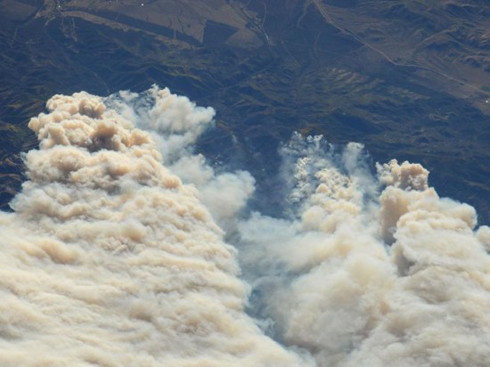
NASA has taken some remarkable pictures of Utah’s fires. Above, the Twitchell Canyon fire as photographed by the Expedition 24 crew aboard the International Space Station… [more]
Let It Burn Fire Updates
The Twitchell Canyon Let It Burn Fire [here, here, here, here] is now over 33,000 acres [38,644 acres as of 9/22]. Interstate 70 is open intermittantly. The power corridor that parallels the Interstate remains threatened and the power is off. Over 500 firefighters are battling the fire, which is reportedly 15% contained. Great Basin IMT2 (Whalen) has taken over fire management from Great Basin IMT2 (Ourada). Ten $million have been spent on “suppression” and “monitoring” to-date.
The Twitchell Canyon Fire has been burning since July 20th (two months ago). The stated purpose of allowing the fire to burn was “to manage the fire for a scenic vegetation mosaic effect”. High elevation mixed conifer forests and brush have been consumed. Extremely high fire intensities have been observed, with flame lengths over 200 feet.
The Sheep Let It Burn Fire [here, here] is now over 7,500 acres (3,078 acs Kings Canyon NP - 4,484 acs Sequoia NF). The fire crossed Lightning Creek on 9/13/10, and is showing approximately 150 to 400 acres of growth per day. Burnouts are underway on the south side of the fire.
The Sheep Fire has been burning since July 17th (over two months ago). The stated purpose of allowing the fire to burn was to achieve “ecological benefits of fire in the Sierra Nevada”. $1.2 million has been spent “monitoring” the fire which began in Kings Canyon National Park but spread to the Sequoia National Forest. Trails are closed. Air pollution has been extensive. Heritage giant sequoia groves are threatened.
Neither of these fires had any sort of NEPA process. No Environmental Impact Statements were prepared. No public review or collaboration was performed. Etc.
2007 Fire Season Federal forest policy Monkeywrenching forests The 2010 Fire Season Useless and Stupid
by admin
leave a comment
The Scenic Vegetation Mosaic Effect
The Fishlake NF offers a novel reason for their Twitchell Holocaust By Idiots Fire [here, here, here]. In numerous pronouncements the USFS claims their purpose in incinerating 20,000+ acres is:
“to manage the fire for a scenic vegetation mosaic effect”
Yup. It’s for the scenery — the old “Blackened Dead Forests Are Beautiful” campaign cooked up by the Wilderness Society on behalf of the Wildland Fire Leadership Council.
Just in case you don’t know what high severity fire does to the viewshed, here are some pics of other “successful” Let It Burn Because It’s So Lovely Projects inflicted on America courtesy your Helpful Federal Bureaucracy.
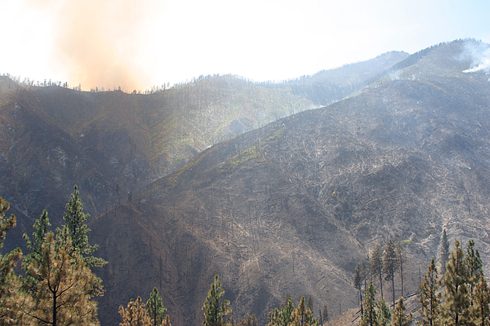
The esthetically pleasing aftermath of the 2007 Let It Burn fires in Central Idaho.
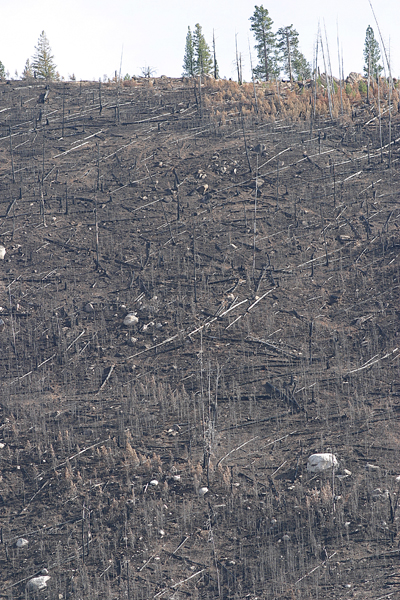
More of the same.
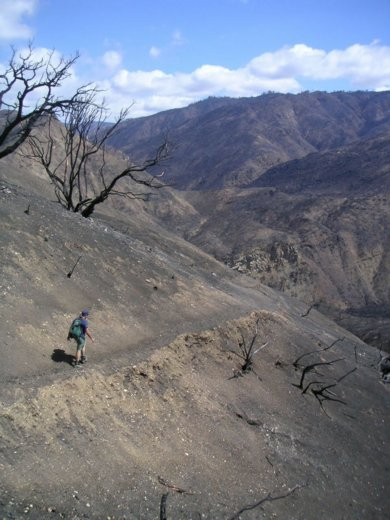
The beauteous Zaca Burn (2007, 240,000 acres, Los Padres NF).
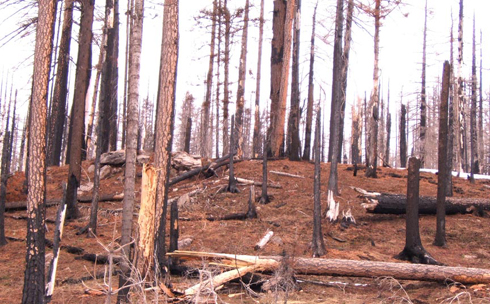
Scenic splendor of the B&B Burn (2003, 90,000 acres, Deschutes NF).
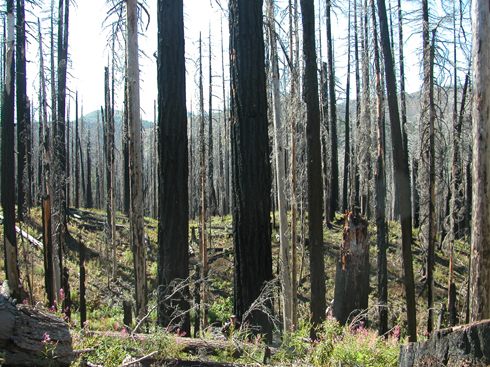
More of the same.
Evidently the USFS has adopted the position of Cascadia Summer, a Eugene “environmental” organization affiliated with Earth First! and the Oregon Natural Resource Council (now Cascadia Wild). In their own words [here]:
Last week [one week before the pictured B and B Fire was ignited] Cascadians paid a visit to the Clark Fire which burned 5,000 acres near Fall Creek earlier this summer. The area is still off-limits to the public, but we wanted to get a first-hand account of just how bad it was… so we quietly hiked in after crossing the stream a ways before the road-block.
The forest looked amazingly beautiful… stark contrast to the lush green forests we were used to seeing along Fall Creek, but beautiful nonetheless. Ferns had already begun sprouting back up through the ash. Scorched Doug Firs and cedars sparkled in the sunlight.
Yes, sports fans, the Federal Gummit wants to beautify your neighborhood and your watershed by turning it into a moonscape. It’s a stark contrast, but what the hey. The Scenic Vegetation Mosaic Effect is all the rage among the arsonist set, and it’s now the Official Mission of the USFS. Gaze in awe at your Gummit in action.
